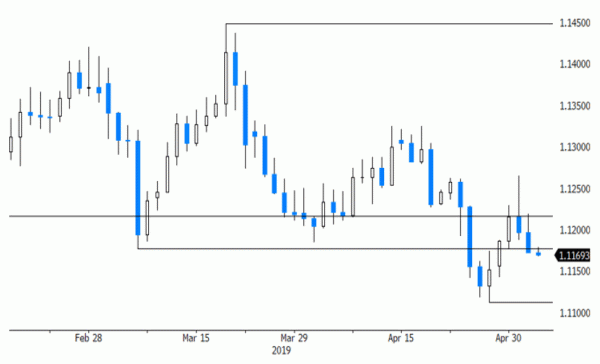Rates: More room for short term losses on wage data?
US Treasuries reacted to Powell’s suggestion that soft inflation is expected to be transient, suggesting they’ll be sensitive to today’s earnings data as well. The bar of consensus seems rather low, suggesting room for more short term correction lower even if headline payrolls and non-manufacturing ISM will probably have more difficulties to beat estimates.
Currencies: US (wage) data to decide on next USD move.
EMU inflation data might have some intraday impact on EUR/USD trading. However, the US payrolls and non-manufacturing ISM will set the tone for USD trading. The data are expected to confirm that the US economy is in good shape but they probably have to be some kind of ‘perfect’ to trigger a big leap higher of the dollar.
The Sunrise Headlines
- US equities lost ground for a second day yesterday with the DJI (-0.46%) underperforming. Asian shares are trading mixed with mainland Chinese and Japanese bourses still closed.
- Bundesbank chief Weidmann urged the ECB to continue normalization if inflation allows it, as he keeps a positive outlook on the EMU eco outlook, while EC president Juncker endorsed Weidmann to succeed ECB president Draghi.
- Stephen Moore has withdrawn his candidacy for a seat on the Fed’s board of governors. Moore lacked support in the Senate over writings on women and is the 2nd candidate backed by US President Trump’s that had to take a step back.
- The UK local elections resulted in losses for both PM May’s Conservatives and the opposition Labour Party. With only part of the votes counted, Conservatives lost 212 councillors, Labour lost 54 while Liberal Democrats gained 145.
- Oil prices dropped to a monthly low yesterday as a US output is reaching record levels (12.3 mln b/d) and output cuts by OPEC+ remain below targeted levels. The price for one barrel Brent crude oil trades just north of $70.
- Australia’s building approvals fell 15.5% (M/M) in March, worse than the 12% decline expected, leading investors to raise the chances of the RBA cutting interest rates next Tuesday. The Aussie dollar fell to a four-month low.
- Today’s US economic calendar contains payrolls and wage data, while the ISM Non-Manufacturing index (Apr) gets released. An avalanche of Fed speakers take the stage. The EMU prints April inflation data.
Currencies: US (Wage) Data To Decide On Next USD Move
US wage growth data key for next USD move?
US and EMU data were mostly second tier yesterday and had only limited impact on EUR/USD trading. The pair initially hovered sideways in the 1.12 area after Wednesday’s Fed-inspired USD comeback. The interest rate spread between the dollar and the euro widened slightly further. The dollar finally enjoyed some additional follow-through gains in the US trading as investors were looking forward to today’s US payrolls report. EUR/USD closed at 1.1172 (from 1.1196). USD/JPY showed no clear intraday trend and in finished at 111.51 (from 111.38).
Today, Asian equities are trading mixed with Japan and China closed. The Aussie dollar lost slightly ground as building approvals (-27.3% Y/Y) dropped more than expected, raising speculation the RBA might already consider a rate cut next week. AUD/USD is extensively testing the psychological barrier of 0.70. The dollar remains rather well bid across the board (DXY at 97.85; EUR/USD near 1.1170/75).
Later, the EMU CPI is interesting, but the US payrolls will be probably be key for global (FX) trading. EMU headline CPI is expected to rise from 1.4% Y/Y to 1.6% (core 1.0 Y/Y from 0.8%). A slight upward surprise, if any, shouldn’t be a big surprise after the German release. We doubt that the figure will be strong enough to really support the euro. April US job growth is expected at a near trend 190K. Markets will also keep a close eye at the wage growth data (AHE expected 0.3% M/M). Investors will challenge Powell’s assessment that recent decline in inflation might be transient. The dollar probably needs strong data to extend its comeback. Later the non-manufacturing is expected to rise from 56.1 to 57. We don’t see much reason for an outright negative surprise from the US data. Still we maintain the view that the EUR/USD 1.1110 support area won’t be that easy to break unless US data are exceptionally strong.
Yesterday, the BoE left its policy rate unchanged, but BoE ‘s Carney indicated that rates will probably have to be raised faster than the markets expects if Brexit is solved in an orderly manner. However, the impact on sterling was modest. EUR/GBP closed at 0.8575 (from 0.8580). Today, the UK services PMI is expected to rebound back above the 50 level. Both the conservative party and labour lost seats in the local elections. Question is whether this will help both parties to find a Brexit compromise anytime soon. For now we expect more technical EUR/GBP trading in the 0.85/0.87 corridor
EUR/USD: will US data be strong enough further dollar to retest the 1.110 support area?


 Signal2forex.com - Best Forex robots and signals
Signal2forex.com - Best Forex robots and signals




